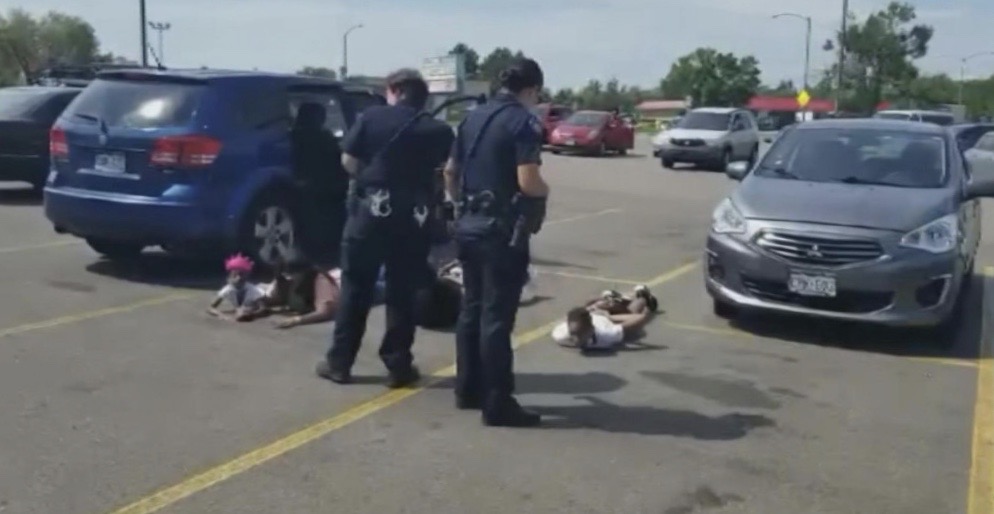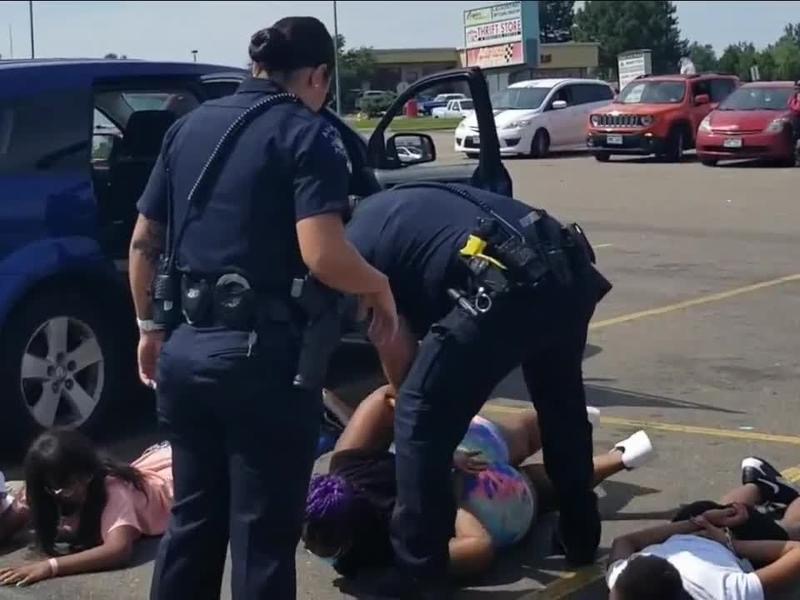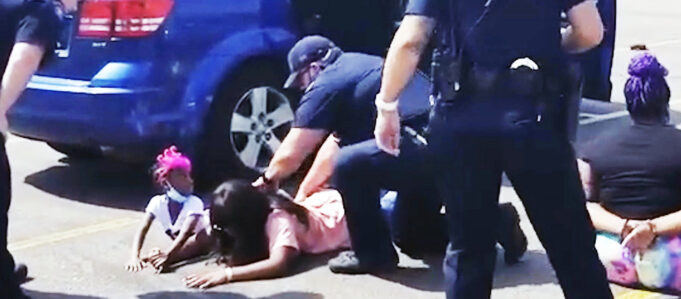It was a particularly hot August day, temperatures topping out at 95 degrees in Aurora, Colo., as screams of children pierced the sky. Desperate they lay handcuffed on their stomachs, hogtied on scorching asphalt like animals. It was to have been a heavenly girls’ day out at the nail salon. Pampering and such Brittney Gilliam planned for her daughter, 6, and her sister, 12, and two nieces, ages 14 and 17.
The day went from heaven to hell in minutes when police pounced, guns drawn, demanding everyone out of a vehicle Aug. 2, cuffing the 17 year old and 12 year old behind their backs. The 14 year old lying next to the 6 year old on their stomachs in the nail salon parking lot.
All of this captured on video.
Police say it was a “mistake.” Cops looking for a stolen motorcycle pulled a “high-risk stop” on a Black family in a van, apparently officers didn’t know how to read letters and numbers for a stolen license plate.
Mothers India Johnson and Yasmeen Winston were out on a play date with their infant children in Washington, D.C., during a 100-degree day. They were on their way to cool off at the fountains near the World War II Memorial.
As they were parking, Secret Service agents smashed into their vehicle, pointed guns at the women demanding they exit, hands in the air. The Black women were handcuffed and detained for an hour, leaving Ms. Winston’s six-month-old son, G’esus, and Ms. Johnson’s 13-month-old son, Sir Quincy, in a hot car unattended, wailing and crying in distress.
Ms. Winston, according to The Daily Mail, had a rifle pointed to her head.
Again, the authorities claimed a “mistake,” saying they thought the car was stolen.

Then there was new police bodycam video showing more of the arrest and death of George Floyd in Minnesota. Police approach his car, guns drawn. Mr. Floyd, clearly in distress, begs the officers, “please don’t shoot me.” He is compliant with police orders to put his hands on the wheel. He willfully exits the car and is handcuffed. Mr. Floyd resists being placed in the police cruiser, saying he is claustrophobic. He asks to be laid on the ground.
Clearly, Mr. Floyd is in a panicked state, perhaps with a premonition something horrible is about to happen. Nothing was done to allay his fears. His alleged misdeed? Handing a store clerk a bad $20 bill.
The Aurora police chief eventually apologized, saying the video made her “sick.” “I want to reach out and just tell the family I am terribly sorry. I am sick to my core that these children were traumatized the way they were,” Chief Vanessa Wilson told the media. Activists quickly pointed out another death, the passing of an unarmed young, Black male, in an encounter with the same police department last year. Elijah McClain, 23, was confronted by officers walking home. He lost his life and none of the officers involved were prosecuted. Some jobs, however, were lost as cops mocked Elijah’s death about year after his loss of life.
According to CNN, the Secret Service is investigating the felony traffic stop and claims some parts of the women’s account are untrue.
What isn’t untrue is a clear lack of compassion in these and other encounters with police that produce trauma, terror and mental torment long after the initial encounter—if the person involved actually lives through it.
While the significant criticism of police departments across the nation is they are racist, abusive, deadly and disconnected from Black communities, they mentally burden Black people.
“Research is now showing that children and adults can experience race-based trauma, which can have profound effects on psychological and physical well-being and can also impact communities as a whole. The threat and experience of police brutality and discrimination can be experienced individually or vicariously, and traumatic symptoms can vary depending on the individual,” observed one study last year.

“Children are especially vulnerable to the psychological and physical effects of police brutality and the threat thereof because of their developmental stages,” according to “Don’t Shoot: Race-Based Trauma and Police Brutality” by Leah Metzger. The study was released by Taylor University in 2019.
It warns, “occurrences and threats of police brutality have immense and diverse effects on Black Americans’ psychological and physical well-being. Children are especially vulnerable to these effects due to their developmental stages, with the potential for lifelong consequences on their brain development, hormonal and immune systems, and self-concept and self-esteem. Additionally, race-based trauma can be experienced repeatedly and cumulatively, as well as vicariously.”
Black people know all too well pain and trauma, from the profoundly immoral abduction called the Middle Passage, to the tortures and dehumanization of slavery, Jim Crow, lynching, medical experiments and forced sterilizations.
Epidemic cell phone documentation of police brutality is the most recent reminder and trauma trigger.
Monnica T. Williams, Ph.D., speaking about vicarious trauma told Teen Vogue, while some were hopeful recording police violence against Blacks would prove it’s a systemic problem, the videos have mostly traumatized Black viewers.
“I think when (these killings) first began to be captured more on video, many of us were excited because we thought we could finally prove what’s been going on all along,” she said. “When that didn’t really make a difference (in society’s perception of police violence), it increased everyone’s despair and distress—so it’s finally come to a boiling point.”

Not only are these videos traumatic, but they can also cause some young people to internalize racism. “Just the fact that media outlets are showing videos of dying Black men is traumatizing in itself. It isn’t considered appropriate to broadcast a White person’s dying moments on television. Still, that dignity isn’t offered to Black people,” Dr. Williams said. “Every time we have to see such videos, it reminds us that society doesn’t value our lives the same.”
Dr. James F. Lassiter, a clinical psychologist from Chesapeake, Va., has a specialty in trauma treatment. He feels for the Black children and what they endured that hot summer day in Aurora, Colo. “I would surmise the children are suffering currently from an acute stress disorder. Give them a couple of weeks, a month you will have PTSD, especially if they are not treated right away,” he warned.
“The police must have been in a cave somewhere not to have seen George Floyd die on his stomach, and my guess is this thing will stay in the children’s minds for some time,” Dr. Lassiter continued. “There is no doubt in my mind the children have an acute stress disorder; I don’t even have to see them. If they are treated immediately, they have a good chance of desensitizing the reaction; if not, the long term effects could be reacting every time the children see a police car, or an authority figure comes near them, or they see something on TV.”
But, he explained, it’s not just the mental and emotional fear associated with racial trauma that is the problem—the stressors have real impact on Black physical health. “An ancillary effect in the Black community is a higher rate of cancer, diabetes, high blood pressure, and heart disease. These are all stress-related disorders, and Black people in this country head the list,” said Dr. Lassister.
“You have a combination of fear, anger, and paranoia. A lot of times, anger when it is not given a proper angle for expression, therapeutically, it turns back against itself as depression or suicide. I think a lot of our young folk are dealing with that type of psychodynamic dysfunction basically, and who is to treat them? Who knows what is going on besides the fact they are considered dangerous and criminal?” he asked.
Philadelphia-based Dr. Portia Hunt, a master clinician and child psychologist, sees these assaults as significant attacks on childhood self-esteem. “The trauma to the children is going to be major,” she said. “Emotionally, what it communicates to them is they have no real value. It’s going to cause the children to have flashbacks, the feeling their parent is marginalized with no real power to protect them. It’s going to have a tremendous impact on the children. Quite frankly, the children were made to feel like a sack of crap.”

“Incidents like this go into the psyche of children sending the message they have no value, the parents are marginalized, the emotional toll is horrific. Then you question why Black children are angry or don’t want to cooperate, withdrawing, becoming docile,” she said.
“There is an absolute connection to the gun violence we see and past trauma with our young people. If you don’t matter, then why not take others out with you? They are interacting with police who are not culturally competent and are there for control. So it creates a connection again that my life is of no value, and neither is yours. It’s a real horrible conundrum,” Dr. Hunt explained.
“I saw the video clip of our sister in Colorado, and I think the most telling visual we can take in was to see the demure six year old wearing a cute pink little princess hat forced to lay on the hot ground,” said Student Minister Ava Muhammad, national spokesperson for the Honorable Minister Louis Farrakhan. “We have been viewed and defined and treated as subhuman, a commodity, for their ability to flourish as a country. But now we are in the last hours of judgment, and so the hatred and contempt for Black people are at the most acute stage ever. We saw that with the torture-murder of George Floyd and the latest bodycam footage that show they had guns drawn on him from the beginning. So what happened to the sister and her little girls and the Black women’s treatment, Black children are being thrust to the forefront.”
“It is leaving us with no other option than to separate from these people. We will never have peace of mind as long as we live like this. How many times have we heard the excuse of mistaken identification? To continually use the same narrative, this is how Breonna Taylor lost her life in such a violent way.”
“We are the recipients of this reckless endangerment, this depraved indifference toward our lives, in the sense that if any type of humanity is shown it would prevent this from happening. But it’s not taken, there is a mindset of White America toward Black people, and it is not going away,” said Dr. Muhammad. And, she added, “Now you have to consider if some of these cases are not a form of retribution for the outpouring of support in the wake of the George Floyd murder.”
She continued, “There are millions of White people outraged over what is taking place, and many are in law enforcement. We are going to constantly live in fear and not know what is around the corner unless we follow Minister Farrakhan’s instructions to begin this process of making our own communities a safe and decent place to live. We need a safe haven, but we can start immediately, and we have done this before. It is not rocket science. It’s just the desire and will to do it. Is it possible to achieve peace of mind living with the children of our slave masters? It is not,” she added.













